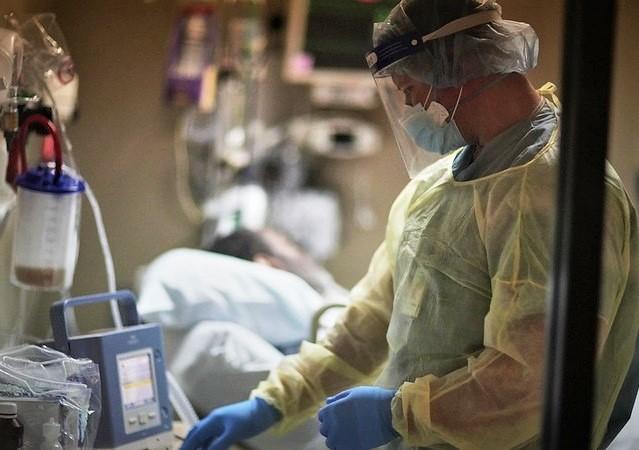Research published yesterday in The Lancet Microbe shows that COVID-19 patients in the United Kingdom in the first wave of the pandemic rarely had bacterial co-infections or secondary infections, yet frequently received antibiotics.
The study by a team of UK researchers looked at data from more than 48,000 COVID-19 patients treated at 260 hospitals in England, Scotland, and Wales from Feb 6 through Jun 8, 2020, and found that only 13% had bacterial co-infections or secondary infections. But 85% received one or more antibiotics during their hospital stay, with broad-spectrum antibiotics used frequently, and more than a third received antibiotics for their illness before being hospitalized.
While several retrospective studies and reviews on antibiotic use in COVID-19 patients have been conducted over the course of the pandemic, and similar findings of low co-infection and high antibiotic use reported, this is the first prospective study of the issue. The authors describe it as the most comprehensive analysis of its kind to date, providing microbiologic details on laboratory-confirmed co-infections and secondary infections in COVID-19 patients.
They say the findings highlight the need for antibiotic stewardship in the treatment of COVID-19 patients.
Low number of confirmed bacterial infections
The research, conducted by scientists with the International Severe Acute Respiratory and Emerging Infections Consortium Coronavirus Clinical Characterization Consortium (ISARIC4C), analyzed data on 48,902 patients with either a confirmed or highly likely SARS-CoV-2 infection. The median patient age was 74 years, and 20,786 of 48,765 patients (42.6%) were women.
Microbiologic investigations were recorded for 8,649 of the 48,902 patients, and clinically significant COVID-19-related infections were identified in 1,107 patients (12.8%) in blood, respiratory, or sputum cultures. Among those patients, 71% had secondary infections, which were defined as having occurred 2 or more days after hospitalization. Of the identified infections, 607 were respiratory and 500 were bloodstream.
Staphylococcus aureus and Enterobacteriaceae were the most common causes of secondary lower respiratory tract infections, while S aureus and Haemophilus influenzae were the most common cause of lower respiratory tract co-infections (those occurring within 2 days of hospital admission). Bloodstream infections were most often caused by Escherichia coli and S aureus.
Among patients with available data, 13,390 (37%) of 36,145 patients had received antibiotics in the community for their illness before being admitted to the hospital. Among 46,061 patients with inpatient antibiotic data, 39,258 (85.2%) received one or more antibiotics at some point during hospitalization. Antibiotic use was highest in March and April 2020, with a higher proportion of critical care patients receiving antibiotics than ward-level patients. The team observed substantial regional variations in antibiotic prescribing.
Beta-lactam/beta-lactamase inhibitor combinations were among the three most prescribed antibiotics, accounting for 30% of all antibiotic prescriptions (co-amoxiclav 19.2%, piperacillin-tazobactam 10.8%). Carbapenems accounted for 3.8% of all prescriptions, while carbapenem-sparing alternatives were used less frequently.
Almost half of all antibiotic prescriptions were from the World Health Organization (WHO) "watch" antibiotic category, defined as broad-spectrum antibiotics with an increased risk of developing resistance.
Findings not surprising
Similar findings have been reported throughout the pandemic. Studies to date have estimated that anywhere from 55% to 98% of hospitalized COVID-19 patients around the world were treated with antibiotics in the early months of the pandemic, while only a fraction had bacterial infections that would require their use.
The high rate of antibiotic use in COVID-19 patients has raised concerns that the pandemic is exacerbating the antibiotic resistance problem.
Among the studies cited in the paper is a rapid review and meta-analysis of 3,338 COVID patients, mostly in Asia, that found that 71.9% received antibiotics while only 6.9% had confirmed bacterial infections (both coinfections and secondary infections). Another review by the same group of researchers found that, of more 30,000 COVID-19 patients treated between January and June of 2020, nearly 75% received antibiotics.
The authors of the UK study say their findings "support and add granularity" to those previous studies. They also say the substantial antibiotic use they observed is unsurprising, given that in the early days of the pandemic few treatments were available for COVID-19 patients, morbidity and mortality were high, and the role and extent of bacterial infections was unknown.
"However, we now know that bacterial co-infection is uncommon in patients with community-acquired COVID-19," study author Antonia Ho, PhD, MBChB, of the MRC-University of Glasgow Centre for Virus Research, said in a news release emailed to journalists. "Since antimicrobial resistance remains one of the biggest public health challenges of our time, measures to combat it are essential to help ensure that these life-saving medicines remain an effective treatment for infection in years to come."
Ho and her colleagues say that antibiotics should be restricted to patients with atypical features of COVID-19, such as clear indications of pneumonia, or evidence of distinct non-respiratory co-infection. To support judicious antibiotic use, they suggest taking blood and sputum cultures before initiating empiric antibiotics to confirm a bacterial infection, and discontinuing antibiotics once a coinfection has been deemed unlikely.
When antibiotics are required, the authors said, the choice of antibiotic should be tailored to likely pathogens and local resistance patterns.























